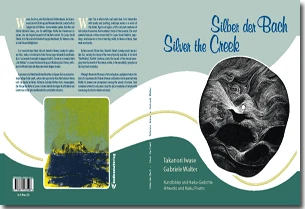Silber der Bach – Silver the Creek
Kunstbilder und Haiku-Gedichte – Artworks and Haiku Poems
von:Takanori Iwase und Gabriele Walter

Beschreibung
Wasser, das ist es, was Künstler und Dichter lieben. Im Zusammenspiel mit Dichtung und Malerei dient die Landschaft als Spiegel des Göttlichen. Immer wieder gehen Künstler und
Dichter deshalb hinaus, um die vielfältigen Kräfte des Universums zu spüren. Der mächtigste Tempel ist oft die Natur selbst. Für Caspar David Friedrich ist die Landschaftsbetrachtung Gottesdienst, für Hermann Hesse sind Bäume Heiligtümer.
Am romantischen Rhein kämmt Heinrich Heines Loreley ihr goldenes Haar, sodass sich die Gestalt des Flusses sogar körperlich emp finden lässt. Tonmalerisch wandelt hingegen Bedrich Smetana in seinem Werk „Die Moldau“ an zwei Bächen entlang zur Mündung des Stroms, während im Mondschein die Nymphen ihren Reigen tanzen.
Auch wenn das Werk berühmter Künstler in diesem Buch nur eine hintergründige Rolle spielt, setzen der japanische Künstler Takanori Iwase und die deutsche Haiku-Dichterin Gabriele Walter darin sirenengleich die Klänge der Natur in Szene. In ihren kleinformatigen Kunstbildern und Gedichten ist die lyrische Melodik klar und direkt erfassbar.
Water: This is what artists and poets love. In its interaction with poetry and painting, landscape serves as a mirror of the divine. Again and again, artists and poets venture out into nature to embrace the bounteous forces of the universe. The most powerful temple is often nature itself. To Caspar David Friedrich, regarding a landscape was a form of worship, while, to Hermann Hesse, trees were sanctuaries.
By the romantic Rhine River, Heinrich Heine’s Loreley combs her golden hair, making the shape of the river physically palpable. In his work “Die Moldau”, Bedrich Smetana paints the sounds of two brooks emerging from the mouth of the stream, while, in the moonlight, nymphs are dancing their roundelay.
Although the work of famous artists only plays a peripheral role in this book, to Japanese artist Takanori Iwase and German haiku poet Gabriele Walter its powers are omnipresent among the sounds of nature. Their miniature artworks and poems sing the lyrical melodies of nature with convincing clarity of content and sound.
Dichter deshalb hinaus, um die vielfältigen Kräfte des Universums zu spüren. Der mächtigste Tempel ist oft die Natur selbst. Für Caspar David Friedrich ist die Landschaftsbetrachtung Gottesdienst, für Hermann Hesse sind Bäume Heiligtümer.
Am romantischen Rhein kämmt Heinrich Heines Loreley ihr goldenes Haar, sodass sich die Gestalt des Flusses sogar körperlich emp finden lässt. Tonmalerisch wandelt hingegen Bedrich Smetana in seinem Werk „Die Moldau“ an zwei Bächen entlang zur Mündung des Stroms, während im Mondschein die Nymphen ihren Reigen tanzen.
Auch wenn das Werk berühmter Künstler in diesem Buch nur eine hintergründige Rolle spielt, setzen der japanische Künstler Takanori Iwase und die deutsche Haiku-Dichterin Gabriele Walter darin sirenengleich die Klänge der Natur in Szene. In ihren kleinformatigen Kunstbildern und Gedichten ist die lyrische Melodik klar und direkt erfassbar.
Water: This is what artists and poets love. In its interaction with poetry and painting, landscape serves as a mirror of the divine. Again and again, artists and poets venture out into nature to embrace the bounteous forces of the universe. The most powerful temple is often nature itself. To Caspar David Friedrich, regarding a landscape was a form of worship, while, to Hermann Hesse, trees were sanctuaries.
By the romantic Rhine River, Heinrich Heine’s Loreley combs her golden hair, making the shape of the river physically palpable. In his work “Die Moldau”, Bedrich Smetana paints the sounds of two brooks emerging from the mouth of the stream, while, in the moonlight, nymphs are dancing their roundelay.
Although the work of famous artists only plays a peripheral role in this book, to Japanese artist Takanori Iwase and German haiku poet Gabriele Walter its powers are omnipresent among the sounds of nature. Their miniature artworks and poems sing the lyrical melodies of nature with convincing clarity of content and sound.
Artikeldetails
| ISBN | 978-3-96103-354-6 |
| Seiten | 54 |
| Genre | Kunst |
| Autor | Takanori Iwase und Gabriele Walter |
| Erscheinungsdatum | 23.04.2018 |
| Preis | EUR 11,95 |
Das sagen unsere Autoren
Copyright © 2025 rediroma-verlag.de. Alle Rechte vorbehalten.





